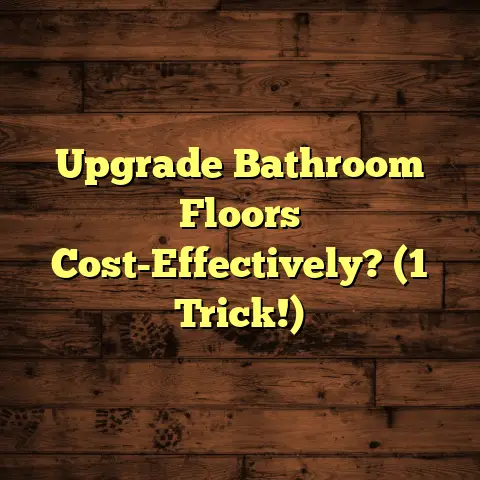Carpet Padding Guide (7 Install Tips Inside!)
Thinking of installing new carpet in your home?
You might believe that choosing the right carpet style and color is the most critical decision.
However, the real game-changer lies beneath your feet: carpet padding.
Many homeowners overlook this essential component, leading to discomfort, premature wear, and increased maintenance costs.
Are you ready to discover how the right carpet padding can transform your flooring experience?
Let’s dive deep into the world of carpet padding, exploring its benefits and uncovering seven essential installation tips that will ensure your carpet lasts longer and feels more comfortable.
Section 1: Understanding Carpet Padding
Okay, let’s start with the basics.
What is Carpet Padding?
Carpet padding, also known as carpet underlay, is a layer of material installed between the subfloor and the carpet.
Think of it as the unsung hero of your flooring system.
It’s not just there to make things feel softer (though that’s a big part of it!).
Different Types of Carpet Padding Materials
Now, let’s talk materials.
I’ve worked with
them all, and each has its own quirks.
Foam: This is a super common type.
You’ll find different kinds, like bonded foam (also called “re-bond,” made from recycled materials – eco-friendly!), prime foam, and memory foam.
Memory foam is amazing for comfort, but can be pricier.Rubber: Rubber padding is known for its durability and resilience.
There are two main types: waffle rubber and flat rubber.
Waffle rubber offers great cushioning, while flat rubber is denser and better for high-traffic areas.Fiber: Fiber padding, often made from natural or synthetic fibers, is a solid choice for those looking for firmness and support.
It’s great for berber carpets and helps prevent stretching.Specialty Pads: Don’t forget about specialty pads!
These can include options like moisture-barrier pads (essential for basements) or sound-reducing pads (a lifesaver in apartments or multi-story homes).
The Benefits of Carpet Padding
Why bother with padding at all? Here’s the scoop:
Comfort: This is the most obvious one.
Padding adds a layer of cushioning that makes walking, standing, and even sitting on the floor much more pleasant.Insulation: Carpet padding acts as a thermal barrier, helping to keep your home warmer in the winter and cooler in the summer.
This can lead to significant energy savings.Noise Reduction: Ever notice how carpet muffles sound?
Padding enhances this effect, absorbing impact noise and reducing sound transmission between floors.Longevity: This is where the real magic happens.
Padding absorbs the impact of foot traffic, preventing the carpet fibers from being crushed and worn down.
A good pad can significantly extend the life of your carpet.
Section 2: Why Carpet Padding Matters
Trust me, I’ve seen what happens when people skimp on padding. It’s not pretty.
The Impact of Quality Padding
I’ve seen firsthand how quality padding can make a huge difference.
A study by the Carpet and Rug Institute (CRI)
found that using the correct carpet padding
can extend the life of your carpet by as much
as 50%!
https://carpet-rug.org/
That’s a massive saving in the long run.
Problems with Improper Padding
On the flip side, improper padding can cause a whole host of problems:
Wrinkling and Buckling: If the padding is too thin or doesn’t have enough density, the carpet can stretch and wrinkle over time.
I’ve had to re-stretch carpets because of this, and it’s not a fun job.Flattening: Over time, low-quality padding can compress and lose its cushioning.
This leads to the carpet flattening out, making it look worn and tired.-
Premature Wear: Without adequate padding, the carpet fibers take the brunt of the impact, leading to faster wear and tear.
Real-World Examples
I remember one customer who insisted on using the cheapest padding they could find to save money.
Within two years, their carpet looked like it was ten years old!
They ended up having to replace the entire carpet, costing them far more than if they had invested in quality padding from the start.
Another client invested in a high-density rubber pad, and their carpet still looks fantastic after five years, even with kids and pets running around.
It’s all about making the right choices upfront.
Section 3: Choosing the Right Carpet Padding
Okay, so how do you pick the right padding for your needs?
It’s not as simple as grabbing the cheapest option at the store.
Factors to Consider
Carpet Type: Different carpets require different types of padding.
For example, berber carpets need firm, dense padding to prevent stretching, while plush carpets benefit from softer, thicker padding for added comfort.Foot Traffic Levels: High-traffic areas like hallways and living rooms need more durable, high-density padding to withstand constant wear.
Low-traffic areas like bedrooms can get away with less dense padding.Room Usage: Basements require moisture-resistant padding to prevent mold and mildew growth.
Apartments may benefit from sound-reducing padding to minimize noise transmission.
Comparing Padding Materials
My Recommendation
For most homeowners, I recommend a high-density foam or rubber pad.
They offer a good balance of comfort, durability, and price.
If you have berber carpet, go with a fiber pad.
And if you’re dealing with moisture issues, definitely invest in a moisture-barrier pad.
Section 4: Preparing for Carpet Padding Installation
Alright, let’s get down to the nitty-gritty.
Before you start slapping down that padding, you need to do some prep work.
Essential Tools and Materials
-
Utility Knife: For cutting the padding to size. Make sure it’s sharp!
-
Measuring Tape: Accurate measurements are key.
-
Straight Edge or T-Square: To ensure straight cuts.
-
Stapler or Seaming Tape: To secure the padding seams.
-
Vacuum Cleaner: To clean the subfloor.
-
Duct Tape: For securing edges and seams (optional, but I find it helpful).
Measuring and Calculating
Measure the length and width of the room carefully.
Add a few extra inches to each dimension to account for trimming and waste.
Multiply the length and width to calculate the total square footage.
Most padding comes in rolls, so you’ll need to figure out how many rolls you need based on the roll size.
It’s always better to have a little extra than to come up short.
Preparing the Subfloor
This is crucial!
The subfloor needs to be clean, dry, and level.
Vacuum thoroughly to remove any dust, dirt, or debris.
If there are any uneven spots, you may need to patch them with a leveling compound.
Make sure the subfloor is completely dry before you start installing the padding.
Moisture can lead to mold and mildew growth.
Section 5: 7 Essential Installation Tips
Okay, here are my top seven tips for a flawless carpet padding installation:
1. Choose the Right Thickness
Padding thickness is measured in inches or millimeters.
The ideal thickness depends on the type of carpet and the level of comfort you want.
Generally, thicker padding provides more cushioning but may not be suitable for all carpets.
For most residential carpets, a thickness of 7/16″ to 1/2″ is a good starting point.
I have seen people go thicker, but that’s usually for a specific feel they are going for.
2. Seamless Installation
Gaps or overlaps in the padding can create bumps and uneven surfaces under the carpet.
To ensure a seamless installation, cut the padding pieces to fit snugly against each other.
Use seaming tape or staples to secure the seams and prevent them from separating.
3. Use Adhesive Sparingly
In most cases, you don’t need to glue the padding to the subfloor.
The carpet itself will hold the padding in place.
However, if you’re installing padding on a concrete subfloor or in a high-traffic area, you may want to use a small amount of adhesive to prevent shifting.
Use a spray adhesive and apply it sparingly to avoid creating a sticky mess.
4. Acclimate Your Padding
Just like wood flooring, carpet padding needs to acclimate to the room’s temperature and humidity before installation.
Unroll the padding and let it sit in the room for at least 24 hours before you start installing it.
This will allow the padding to expand or contract as needed, preventing wrinkles and buckles down the road.
5. Cut to Fit
Use a sharp utility knife and a straight edge to cut the padding to fit the room’s dimensions.
Cut slightly larger than the room and then trim the excess.
Pay close attention to corners and doorways, and make sure the padding fits snugly against the walls.
6. Secure the Edges
To prevent the padding from shifting and moving under the carpet, secure the edges with duct tape or staples.
This is especially important in high-traffic areas and along doorways.
7. Test for Comfort
Before you lay the carpet, walk on the installed padding to make sure it feels comfortable and supportive.
If you notice any uneven spots or areas that feel too soft or too firm, make adjustments as needed.
It’s much easier to fix problems now than after the carpet is installed.
Section 6: Common Mistakes to Avoid
Let’s talk about some common pitfalls I’ve seen homeowners fall into:
Using the Wrong Padding Type: As I mentioned earlier, different carpets require different types of padding.
Using the wrong padding can lead to premature wear and other problems.-
Skipping the Subfloor Prep: A dirty, uneven subfloor can cause the padding to wear out faster and can even damage the carpet.
-
Not Measuring Accurately: Inaccurate measurements can lead to gaps, overlaps, and other installation problems.
-
Using Dull Blades: A dull utility knife can make it difficult to cut the padding cleanly and can even be dangerous.
-
Ignoring Manufacturer’s Instructions: Always read and follow the manufacturer’s instructions for both the carpet and the padding.
Section 7: Maintenance and Care of Carpet Padding
Once your carpet and padding are installed, there are a few things you can do to keep them in good condition:
Vacuum Regularly: Vacuum your carpet at least once a week to remove dirt, dust, and debris.
This will help prevent the padding from becoming compacted and worn down.-
Clean Spills Immediately: Clean up spills as soon as they happen to prevent staining and damage to the carpet and padding.
-
Use Carpet Cleaners Sparingly: Overuse of carpet cleaners can damage the carpet fibers and can even cause the padding to break down.
When to Replace Padding
Even with proper care, carpet padding will eventually need to be replaced.
Here are some signs that it’s time for a change:
-
Loss of Cushioning: If your carpet feels flat and hard, it’s likely that the padding has lost its cushioning.
-
Wrinkling or Buckling: These can be signs that the padding is no longer providing adequate support.
-
Musty Odor: A musty odor can indicate mold or mildew growth in the padding, especially in basements.
Conclusion
So, there you have it!
Everything you need to know about carpet padding, from understanding its benefits to installing it like a pro.
Remember, carpet padding is more than just a comfort layer.
It’s an investment in the longevity and performance of your carpet.
Take the time to choose the right padding and install it correctly, and you’ll enjoy a comfortable, beautiful, and long-lasting carpet for years to come.
With the right preparation and knowledge, anyone can tackle carpet padding installation successfully.
Good luck, and happy flooring!





